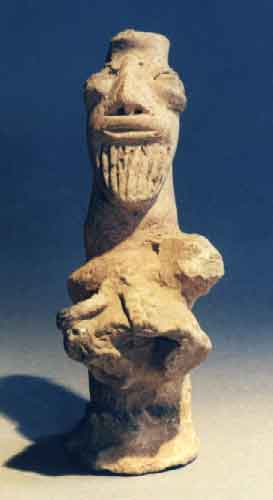
The Spirit of the Thing
Tribal Art at Betty Cuningham Gallery
By Maureen Mullarkey
THE PREMISE OF “IT’S ALL SPIRITUAL,” AN EXHIBITION OF TRIBAL ART at Betty Cuningham Gallery, is fair enough: “All great art — to one degree or another — has a spiritual component.” What counts, of course, is the character of that component and the nature of the spirit involved. Not every spirit is benevolent.
 |
| Koma terra cotta, Ghana |
To hold our page in the multicultural hymnal, we need a way around inconvenient cultural realities. Luckily, we have one in our own free-range aestheticism and that distinctly Western construct: the presumption of universally appealing formal properties and its imposition on the material relics of non-Western cultures. Artifacts that represent beliefs and practices we are thankful to be spared are all candidates for appreciation. Like a bishop conferring holy orders, formalist ideology granted the status of art (Clive Bell’s “significant form”) to everything from tools to shrunken heads. There is no going back. At least not until the heads turn out to be our own.
Meantime, nothing lights up the foyer quite like a war club or someone else’s funerary effigy. “It’s All Spiritual” showcases a wide selection of objects from a variety of regions and cultures, including Native American, Meso American, Melanesian, Polynesian, Indonesian, African and Chinese. Entries date from 11 BCE to the early 20th century. The exhibition was assembled by Alan Steele, an artist-turned-private dealer. Selected in part from Steele’s own collection, the exhibition displays an artist’s eye for dramatic sculptural volume, textural and graphic interest.
A consumer-friendly spirit animates this eclectic collection. It has the allure of an odd-lot auction: decorated Pueblo bowls, Tlingit baskets, small shamanic utensils (e.g. a vomit spatula from Dominican Republic; a Melanesian chief’s pudding knife), a Sioux story-drawing on muslin, two watercolors on ledger paper, Tahitian tapa cloth, fetishes, divinities, shields and a variety of masks. All is arranged to good effect, minimizing the fact that the arthood of certain objects is less perceptible than others
Contemporary audiences do not see these things as their makers saw them: functional items for daily living. (Or, in anthropologist Alfred Gell’s term “magical technology.” ) We view them through the prism of modernism, its anti-classical bias and the emergence of abstract art. On pedestals and against while walls, a Papuan spirit mask or Mali hyena face seems oddly familiar. Picasso’s damoiselles showed them to us a century ago.
Under gallery lights, figures once inhabited by gods or ancestral ghosts are emptied of purpose, vacant as logs on Walden Pond. Consider, for instance, a ferocious looking Congolese fetish, pierced with nails. A repository of immeasurable power against a battery of evil spirits, the nkondi was not made to please but to strike awe and humility — that mysterium tremens that defines the holy — in its beholders. No one dare lie or swear a false oath in front of it. Here, disembedded from its cultural context and aestheticized, it shrivels to a collectible, a primitive St. Sebastian.
Local practice illustrates the distance of tribal art from Western aesthetic interests.
Malangan figures from New Ireland, such as the late 19th century painted rainmaker figure here, were laboriously produced. Yet, like much tribal art, these were often casually discarded or burned following the ritual for which they were created. Since wood deteriorates easily, items dating back to the 19th century are relatively scarce. (Provenance is paramount in a field acknowledged to be riddled with fakes.)
Death is a recurrent theme of tribal objects made for ceremonial use. One haunting 18th or 19th century Yao mask from Southern China, derives much of its impact from its recognizable affinity with the Western vanitas tradition. Another piquant sculpture is a male tau tau, a Sulawesi funerary effigy missing its arms and burial costume, and wearing only a mildly baffled expression.
Among tribes on Sulawesi, elaborate funerals are the central cultural event, often lasting for days. The scope of festivities establishes the status of the family who funds them and encourages the newly dead to stay put and not become troublesome ghosts. Blood of a sacrificed pig is smeared on the commissioned tau tau. It is fully dressed and placed in a mortuary gallery chiseled into rock. Until resources are marshaled for funeral expenses, the departed one is not declared dead but stored, neatly wrapped, at home.
It is impossible to walk through this exhibitiion without thinking of Evan Connell’s novel “The Connoisseur.” Connell’s aspiring connoisseur, Muhlbach, is bored by his tour of a collector’s private museum. While the collector brags about the quality of his pieces, Muhlbach decides: “But finally, what matters is whether or not you identify with the spirit of a work.”
If that were so, we might feel obliged to cover the tau tau, cleansed now of blood and the stench of decay, and pray for the dead.




“It’s All Spiritual: Art from Tribal Cultures” at Betty Cuningham Gallery
(541 West 25 Street, 212-242-2772).
This essay first appeared in The New York Sun, June 14, 2007.
Copyright 2007, Maureen Mullarkey







